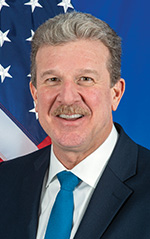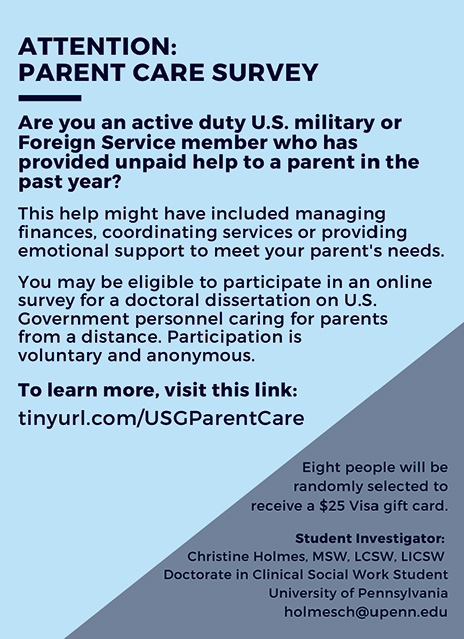On CSO’s 10-Year Anniversary: Stabilization Operations in Perspective
State’s Bureau of Conflict and Stabilization Operations has amassed the experience and expertise to lead on stabilization and resilience policy.
BY ROBERT J. FAUCHER AND JOHN H. MONGAN
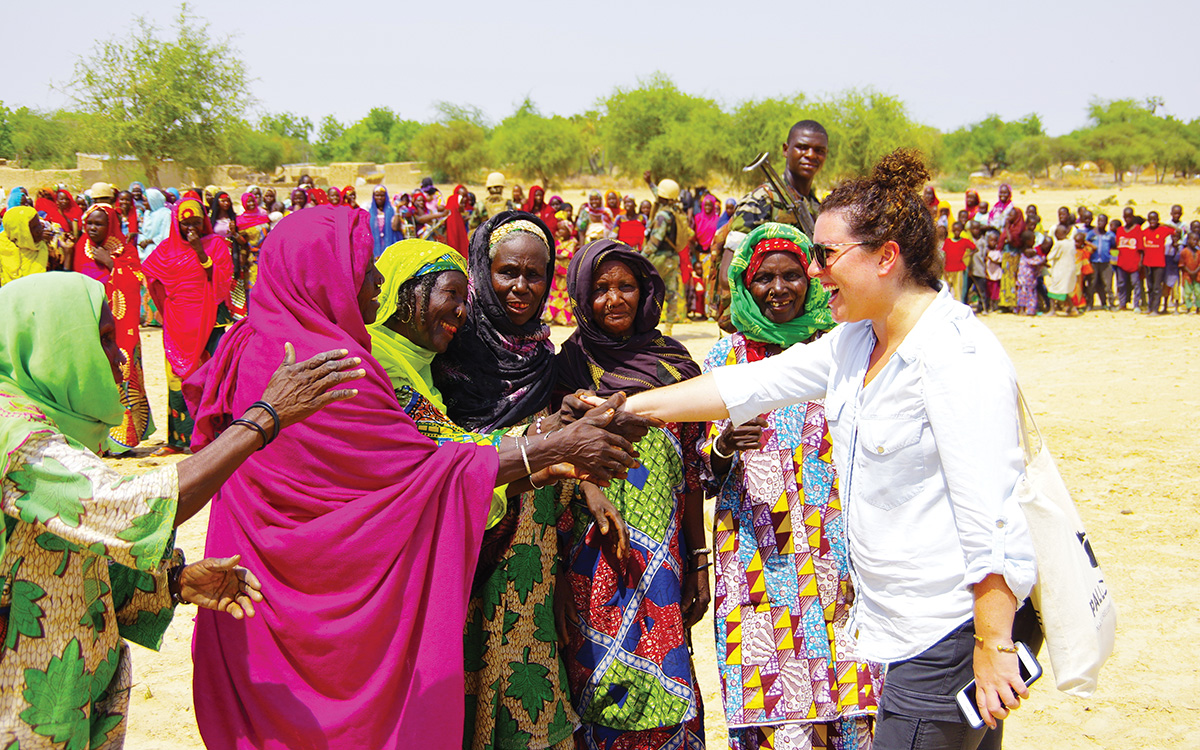
Stabilization/Conflict Adviser Aneliese Bernard meets with refugees from unstable regions of Nigeria in the Diffa Region of Niger in 2018.
U.S. Department of State
The recent events in Afghanistan remind us that we must continue to learn lessons about conflict. This fall marks the 10-year anniversary in November of the Bureau of Conflict and Stabilization Operations (CSO). It is incumbent upon people who call themselves experts in “conflict prevention and stabilization” to exercise a certain humility and reflection at this time, yet also important to recognize CSO as the embodiment of one of the “Forever War’s” most important lessons for State—that conflict prevention and stabilization is a field of diplomatic expertise akin to trade or arms control, and the department needs an institutional home for that expertise to prevent and respond to current and future conflict.
Building on an organization formed specifically in response to events in Iraq and Afghanistan, CSO has evolved over the past decade from what originally was envisioned as a “whole-of-government czar for Reconstruction and Stabilization” into a functional bureau within State’s J family of civilian security offices and bureaus. Now more like “Diplomatic Special Forces” than an expeditionary civilian “surge,” CSO supports other department entities in formulating and implementing stabilization policy. CSO’s core capabilities—and policymakers’ needs—have remained constant: deep analysis of conflict’s drivers; rigorous planning of the U.S. approach to conflict; and agile deployment of conflict-expert diplomats where needed.
In the future, the U.S. government—and CSO, in particular—must continue to evolve and innovate to meet increasingly complex violence and conflict around the world. Rather than an overhaul, CSO should continue to deepen its core capabilities, adding further nuance in the following ways:
- Refining U.S. conflict analysis and policy—keeping ahead of new factors affecting conflict, like pandemics and climate change;
- Reforming risk management—getting back into the field to find and engage new local partners;
- Enhancing mediation and negotiation support—assisting parties who often do not know what they do not know about making peace; and
- Investing in data and technology—learning to value gaming as the private sector and military do.
From Reconstruction and Stabilization to Conflict Stabilization
Throughout the 1990s, national security professionals debated what was needed to adapt to increasingly frequent “complex operations” as experienced in Somalia, Haiti, Rwanda and the Balkans. The post-9/11 military operations in Afghanistan and Iraq revealed that civilian agencies lacked capabilities for reconstruction and stabilization (R&S) operations, generally understood as “nation-building.” These efforts were envisioned as highly technocratic and multisectoral, akin to U.S. postwar efforts in Germany and Japan—heavy on assistance programming and building state capacity.
It was in this atmosphere in 2004 that then-Senators Joseph Biden and Richard Lugar proposed the Reconstruction and Stabilization Civilian Management Act. That legislation aimed “to provide for the continued development, as a core mission of [State and USAID], of an effective expert civilian response capability to carry out reconstruction and stabilization operations in a country or region that is at risk of, in, or is in transition from, conflict or civil strife.”
Soon after the legislation was proposed, Secretary of State Colin Powell created the Office of the Coordinator for Reconstruction and Stabilization (S/CRS). In 2005, the George W. Bush administration followed up with National Security Presidential Directive-44, giving State specific guidance to “prepare for, plan, and conduct [reconstruction and stabilization] operations.” After several years of S/CRS initiatives to test these concepts, Secretary of State Hillary Clinton turned S/CRS into the Bureau of Conflict and Stabilization Operations (CSO) in 2011, refining its task to “serve as the institutional locus for policy and operational solutions for crisis, conflict and instability.”
The change from S/CRS to CSO was both intellectual and bureaucratic. Intellectually, by 2011 conditions in Afghanistan and Iraq had undercut the technocratic assumptions behind “reconstruction and stabilization,” leading to the removal of “reconstruction” as overly ambitious. Organizationally, CSO would no longer aspire to be a “whole-of-government czar.” Instead, it would be a department functional bureau focused on conflict.
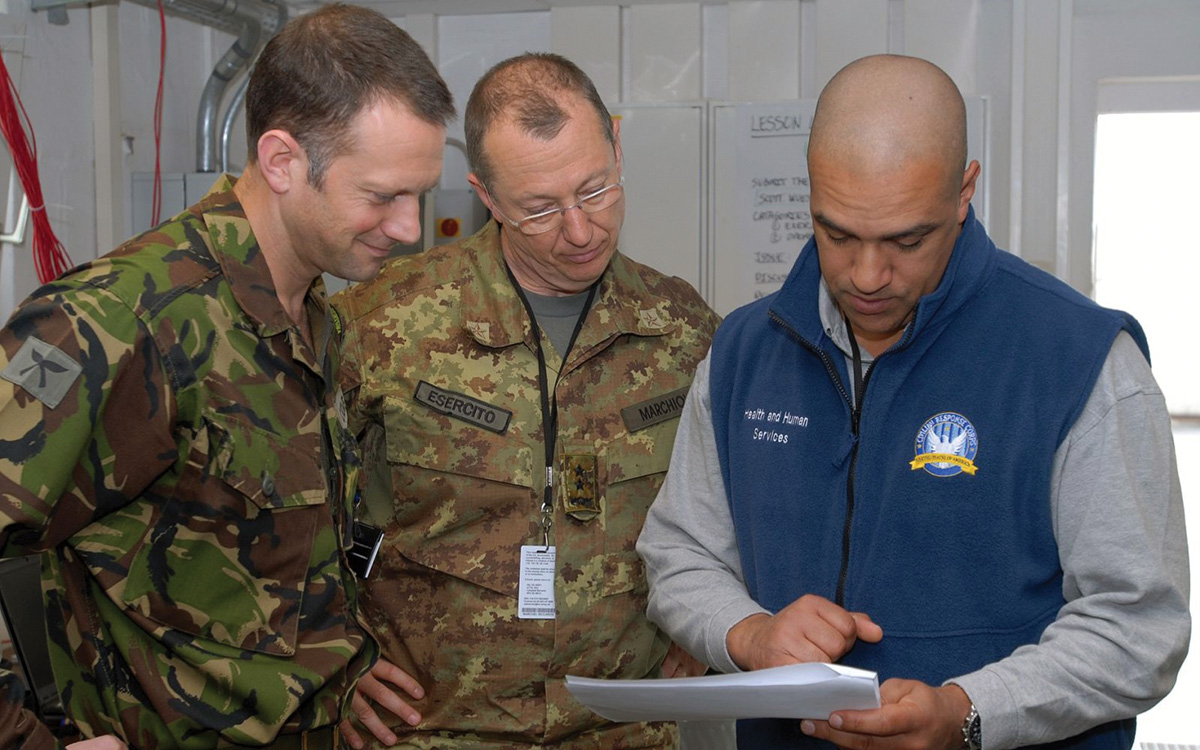
Health and Human Services Civilian Response Corps member Jean Pierre DeBarros, at right, discusses plans with NATO colleagues from the U.K. and Italy during a NATO exercise in Germany in 2009.
U.S. Department of State
Although State decided CSO would be its locus for stabilization, no one formally defined stabilization for the U.S. government until 2018, when Secretary of State Rex Tillerson, Secretary of Defense James Mattis and USAID Administrator Mark Green agreed on the Stabilization Assistance Review that defined stabilization as: “a political endeavor involving an integrated civilian-military process to create conditions where locally legitimate authorities and systems can peaceably manage conflict and prevent a resurgence of violence. Transitional in nature, stabilization may include efforts to establish civil security, provide access to dispute resolution, deliver targeted basic services, and establish a foundation for the return of displaced people and longer-term development.”
The 2018 Stabilization Assistance Review correctly placed the onus for stabilization policy on the State Department, reflecting the lesson that while the Defense Department and USAID play essential roles in stabilization, they cannot succeed if State does not succeed in the diplomatic realm—first, in building an international consensus around a conflict; and second, in promoting the political reforms and reconciliation needed for more stable and resilient societies to grow. The Stabilization Assistance Review enshrined the resulting division of labor among the “three Ds”—which later received congressional endorsement in the bipartisan 2020 Global Fragility Act. State was clearly given the lead for stabilization and resilience policy.
Deployable Diplomats: “Expeditionary” or “Special Operations”?
Accompanying this institutional evolution was refinement of the tools to have at hand. The Biden-Lugar Act called for a Civilian Response Corps of 250 full-time active, rapid-deployment officers; 2,000 standby volunteers recruited among existing U.S. government employees; and 2,000 reserve personnel drawn from key nonfederal skill sets such as municipal administration. Unfortunately, in 2005 S/CRS received only 15 temporary Foreign and Civil Service billets to build a prototype Active Response Corps.
Despite the ARC’s small size, by 2008 its successful performance in places like Darfur and Kosovo—and domestic agencies’ struggles to staff “surges” in Iraq and Afghanistan—prompted Congress to pass the Biden-Lugar Act and appropriate funds for establishment of the Civilian Response Corps, drawn from the departments of State, Treasury, Justice, Agriculture, Commerce, Health and Human Services, Homeland Security and USAID—providing all the skill sets needed to run a city or small country. In four short years under Coordinator John Herbst, the corps made notable contributions to U.S. efforts in Afghanistan, Kyrgyzstan and South Sudan.
The Civilian Response Corps also revealed numerous conceptual flaws. Its reserve wing never came to be, because Congress would not enact the kinds of employment protections military reservists enjoy. The standby corps learned there really are not loads of civil servants who can be spared from their day jobs in the United States. The active division was full of highly skilled technocrats for “reconstruction,” but actual missions required diplomatic and planning skill sets for “stabilization.”
CSO’s first assistant secretary, Rick Barton, envisioned CSO field operations less as “expeditionary surges” of personnel and more like small, civilian “special operations” teams—not unlike his previous brainchild, USAID’s Office of Transition Initiatives, which “provides fast, flexible, short-term assistance to take advantage of windows of opportunity to build democracy and peace.”
The big difference under Assistant Secretary Barton was that CSO’s officers were diplomats first, program managers second. CSO’s programs gave deployed officers venues to engage people on behalf of the United States. CSO staff designed and conducted activities alongside implementing partners and beneficiaries, while sending back political analysis to Washington.
A persistent and repeated failure across history has been the failure to understand that the preservation of peace requires active planning, the expenditure of resources and sacrifice, just as war does.
–Donald Kagan, On the Origins of War
CSO’s unique approach made notable contributions to U.S. policy in Honduras, Nigeria, Kenya and Burma. Most significantly, it was the keystone of U.S. support to the Syrian opposition from 2012 to 2015. But the fallout from Benghazi in 2012 squelched further department interest in potentially high-risk missions, and a new under secretary, Sarah Sewall, valued CSO’s analytic capabilities more than its field work.
Since 2015, CSO’s overseas work has tended to involve individual stabilization advisers providing conflict-specific expertise to support select embassies. Recent high-impact deployments include working in Kyiv alongside conflict monitors from the Organization for Security and Cooperation in Europe; securing defections from ISIS–West Africa in Niger; researching the dynamics of hybrid and nonstate armed groups in Libya, Yemen and Iraq; and increasing compliance with Colombia’s peace accord.
Pioneering Analysis and Planning
Early on, S/CRS embraced one of the first lessons of Iraq and Afghanistan: Stabilization requires a degree of planning far more rigorous than normally required in diplomacy—both to define policy goals clearly and to know whether they are being achieved.
In addition to deployment of a cohort of stabilization advisers, S/CRS pioneered methods of facilitated, qualitative conflict analysis and planning designed to get all the players around a table agreed on a common understanding of, and approach to, the conflict at hand. S/CRS’ Interagency Conflict Assessment Framework chalked up successes once its use was tied to posts’ ability to receive more than $400 million in Section 1207 funding for stabilization programs from the Defense Department.
Between 2008 and 2011, S/CRS’ analysis and planning capability made important contributions to the Afghan counterinsurgency campaign’s design, monitoring and evaluation process with S/CRS planners deployed in Washington, Kabul and the field. Overall, the tug between planning and field work peaked and troughed throughout CSO’s history. For example, Barton deemphasized planning as a service for CSO “clients,” but internalized its value for designing CSO’s operations.
Assistant Secretary Barton also recognized the role data analysis could play in both anticipating conflict and evaluating the effectiveness of U.S. responses. He stood up CSO’s first advanced analytics unit, which today is its own office, running the Instability Monitoring and Analysis Platform—IMAP, which any State officer can access from their desktop. IMAP puts CSO at the cutting edge of the department’s use of data analytics. Among its top priorities is adjusting the data proxies used by IMAP to better capture climate change’s impact on violence and improve its predictive capacity.
Today, CSO elevates data in both planning and operations. It facilitates strategic planning and interagency coordination, often serving as a translator across the 3D community. It provides niche field interventions on targeted issues such as atrocity early warning, network analysis of hybrid and nonstate armed groups, reintegration of ex-combatants and advancement of peace processes and cease-fires.

Stabilization Adviser Amy Truesdell, at top, works with other international observers to track risks of violence during Kenyan elections in 2013.
U.S. Department of State
The Future of Stabilization: Foresight, Agility and Rigor
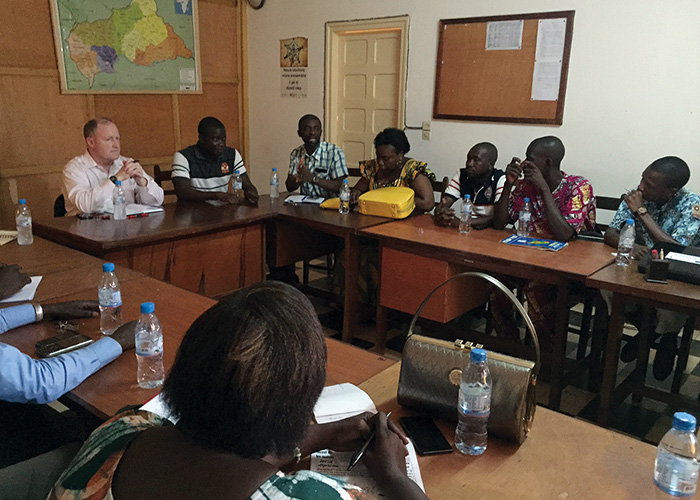
Stabilization Adviser Marty Regan, top left, meets with civil society leaders to discuss a CSO-funded program involving community-level social cohesion programs aimed at vulnerable youth in Bangui, Central African Republic, in April 2016.
U.S. Department of State
Just as the international understanding of conflict prevention and stabilization evolved in the past 10 years, so must we continue to evolve for the next decade.
Refining U.S. Conflict Analysis and Policy. In his memoir, Foreign Service, Ambassador James Dobbins vividly illustrated policymakers’ disinterest in insights from conflicts like Haiti and the Balkans when discussing Afghanistan in the critical months after 9/11, when key decisions were made that would shape the ultimate outcome of the venture. CSO’s analysis and planning capability cannot compel good policy, but at least policymakers today have access to a one-stop shop of institutional knowledge that did not exist in 2001.
The Biden administration has particularly stressed the need to address climate change as a driver of conflict and state fragility. Conflict prevention and climate change share the same unfortunate problem: The human brain is not well programmed to tackle either, and we have too few bridges between the politics and the science. We respond to the crisis in front of us, but our tendency with longer-term complex challenges is to revert to equally unwarranted optimism or fatalism.
The nexus between climate and conflict is real: Of the 20 countries the International Committee of the Red Cross considers most vulnerable to climate change, 12 are already experiencing armed conflicts. Resource disputes that once could be managed now goad people to take up arms. Attempts to mitigate and adapt to climate change likely will spur their own conflicts, as new energy economies and environmental effects create new winners and losers.
Reforming Risk Management. Some of S/CRS’ and CSO’s best work over the years involved small diplomatic teams far afield, often with military partners as in provincial reconstruction teams, but the post-Benghazi political environment reinforced a risk-averse department culture. CSO is addressing the resulting atrophy. It is forming a Rapid Response Team to reestablish a “special operations” deployment capacity. It is also rebuilding its capacity for joint civilian-military deployments to get CSO’s trained conflict operators beyond the embassy walls, where they need to be to influence local populations and convey insights to policymakers.
Enhancing Mediation and Negotiation Support. Multilateral mediation and negotiation, especially at the grassroots and involving nonstate groups, is very different from bilateral or multilateral exchanges between sovereign governments. Following the United Nations and other international organizations and partners, CSO is adding staff and training to meet increasing demand for technical support for mediation services and peace process negotiations.
Investing in Data and Technology. While IMAP is now available on every State desktop, this is just the start of data-analytic support to diplomacy. CSO regularly runs simulations of negotiations and peace processes, “war-gaming” potential scenarios to help policymakers guide their talks. As artificial intelligence’s capabilities grow, AI-enabled gaming and modeling likely will prove even more valuable tools. Policymakers will be able to mix and match offers, trade-offs and partners to see what outcomes are desirable and achievable. CSO is investing in technology and data analytics specialists and funding new or expanded public datasets to ensure the United States can take advantage of the latest tools for diplomacy.
Many of the lessons learned by S/CRS and CSO are now enshrined in law and policy. CSO is State’s lead for implementing the Elie Wiesel Genocide and Atrocities Prevention Act of 2018, and the bureau co-leads implementation of the 2019 Global Fragility Act and the 2018 Stabilization Assistance Review with the Office of the Director of Foreign Assistance. These are significant prevention policy initiatives. The GFA mandates that the executive branch develop 10-year plans for identified countries and calls for negotiating compacts with their governments to condition further assistance. The Elie Wiesel Act requires assessments and prevention plans for the 30 highest-risk countries. These efforts require stabilization advisers with highly developed expertise and data-analytic backgrounds, who can lead planning and evaluation of policy and programs in both Washington and challenging field locations.
Afghanistan will not be America’s last stability challenge. CSO, and its mandate, do not just reflect the lessons that thousands of U.S. personnel sweated and bled for in Afghanistan—they memorialize them. Having developed and refined these capabilities through years of trial and error, it is now up to policymakers to use them effectively.
Read More...
- “Getting Preventive Stabilization on the Map,” by David C. Becker and Steve Lewis, The Foreign Service Journal, September 2019
- “US State Department connecting dots between conflict and COVID-19,” by Teresa Welsh, Devex, July 7, 2020
- “Lessons from the U.S. Civilian Surge in Afghanistan, 2009-2014,” by Peter Erickson et al, Woodrow Wilson School, January 2016

